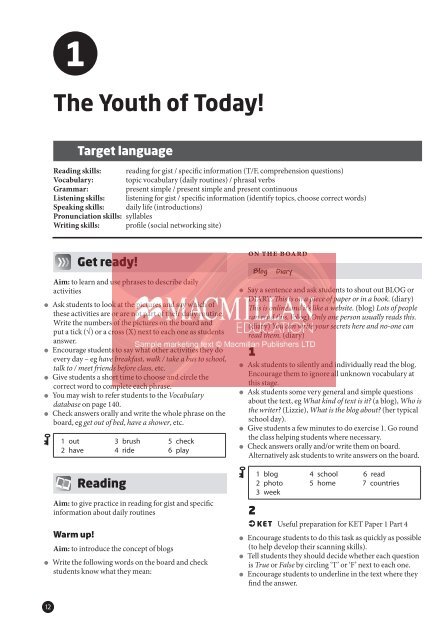Laser A2 TB - Unit 1 - The Youth of Today!
You also want an ePaper? Increase the reach of your titles
YUMPU automatically turns print PDFs into web optimized ePapers that Google loves.
1<br />
<strong>The</strong> <strong>Youth</strong> <strong>of</strong> <strong>Today</strong>!<br />
Target language<br />
Reading skills: reading for gist / specific information (T/F, comprehension questions)<br />
Vocabulary: topic vocabulary (daily routines) / phrasal verbs<br />
Grammar:<br />
present simple / present simple and present continuous<br />
Listening skills: listening for gist / specific information (identify topics, choose correct words)<br />
Speaking skills: daily life (introductions)<br />
Pronunciation skills: syllables<br />
Writing skills: pr<strong>of</strong>ile (social networking site)<br />
P<br />
●●<br />
●●<br />
●●<br />
●●<br />
●●<br />
●●<br />
Get ready!<br />
Aim: to learn and use phrases to describe daily<br />
activities<br />
Ask students to look at the pictures and say which <strong>of</strong><br />
these activities are or are not part <strong>of</strong> their daily routine.<br />
Write the numbers <strong>of</strong> the pictures on the board and<br />
put a tick (√) or a cross (X) next to each one as students<br />
answer.<br />
Encourage students to say what other activities they do<br />
every day – eg have breakfast, walk / take a bus to school,<br />
talk to / meet friends before class, etc.<br />
Give students a short time to choose and circle the<br />
correct word to complete each phrase.<br />
You may wish to refer students to the Vocabulary<br />
database on page 140.<br />
Check answers orally and write the whole phrase on the<br />
board, eg get out <strong>of</strong> bed, have a shower, etc.<br />
1 out 3 brush 5 check<br />
2 have 4 ride 6 play<br />
Reading✔<br />
Aim: to give practice in reading for gist and specific<br />
information about daily routines<br />
Warm up!<br />
Aim: to introduce the concept <strong>of</strong> blogs<br />
<br />
P<br />
✔<br />
Write the following words on the board and check<br />
students know what they mean:<br />
7<br />
●●<br />
●●<br />
●●<br />
●●<br />
●●<br />
●●<br />
●●<br />
●●<br />
On the Board<br />
Blog Diary<br />
Say a sentence and ask students to shout out BLOG or<br />
DIARY: This is on a piece <strong>of</strong> paper or in a book. (diary)<br />
This is online and it’s like a website. (blog) Lots <strong>of</strong> people<br />
can read this. (blog) Only one person usually reads this.<br />
(diary) You can write your secrets here and no-one can<br />
read them. (diary)<br />
1<br />
Ask students to silently and individually read the blog.<br />
Encourage them to ignore all unknown vocabulary at<br />
this stage.<br />
Ask students some very general and simple questions<br />
about the text, eg What kind <strong>of</strong> text is it? (a blog), Who is<br />
the writer? (Lizzie), What is the blog about? (her typical<br />
school day).<br />
Give students a few minutes to do exercise 1. Go round<br />
the class helping students where necessary.<br />
Check answers orally and/or write them on board.<br />
Alternatively ask students to write answers on the board.<br />
1 blog 4 school 6 read<br />
2 photo 5 home 7 countries<br />
3 week<br />
2<br />
A KET Useful preparation for KET Paper 1 Part 4<br />
Encourage students to do this task as quickly as possible<br />
(to help develop their scanning skills).<br />
Tell students they should decide whether each question<br />
is True or False by circling ‘T’ or ‘F’ next to each one.<br />
Encourage students to underline in the text where they<br />
find the answer.<br />
12



